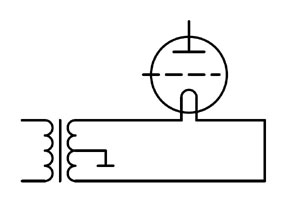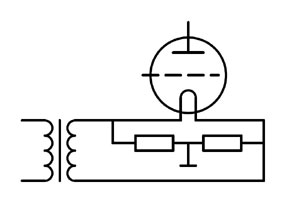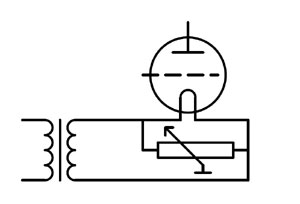Tubeamp Power Supply
- Gas Stove or Ceramic Glass Hob -(パワーサプライ真空管アンプ | 电子管放大器電源變壓器)
Supply voltage
Modern, semiconductor-rectified stabilized power supplies make sense for example for high gain phono amps. But tube rectifiers are much more appealing, not alone visually, but as far as the sound for line amps and power triodes goes as well.Like with the triodes there are direct and indirect heated types of rectifier tubes, usually available as two phase or full wave rectifiers.
The circuit is simple and allows essentially two different methods: Capacitor input and choke input.
The biggest practical difference between capacitor input and choke input is the different output voltage achieved, which is considerably lower with the choke input. Which means that you’ll need a significantly larger transformer (volt-amperes) for power-hungry amplifiers when you use choke-input. For the less power-hungry pre-amps you can experiment a bit more and for example use a transformer with multiple taps to switch between the variants. But please note that the choke in circuits with choke input is subjected to different loads and must be designed accordingly.
So for the chokes you have to check the current-load capacity and inductivity. And: compared to an ohmic resistance, with flowing bias current the filter effect increases, thus minimizing the benefits using chokes for the pre-amplifier usually has, sound-wise.
You have to take special care with the first filter input capacitor which should not be too large. You can find out about the limiting values in the relevant data sheets for the rectifier tubes. In general, a large capacitor means a high filter factor. But you shouldn’t necessarily max out the limit.
You can connect several filter stages, according to your personal wishes. But be careful - less is more. If you can still hear buzzing and humming, even with three filter stages, in most cases the filtering isn’t the reason. At least in one place between the filter links you should also install a discharge resistor, between plus and minus (approx. 470k/680K, 2 watts).
It’s important to use capacitors with sufficient electric strength and resistors with sufficient power rating. Especially when switched on the amplifier can show completely different conditions than in its operating status, depending on the chosen concept.
In this context you have to consider the different behaviour of direct and indirect heated tubes of the triodes as well as of the rectifier tubes. With indirect heated tubes the cathode needs longer to reach operating temperature and bias current. So, if you connect a direct heated rectifier tube with indirect heated triodes, at first you’ll see the full DC voltage behind the rectifier tube and at the anodes of the signal tubes. Only the bias current takes care of the voltage drop across the filter and anode resistors. Which is why it makes sense to use either only direct heated or only indirect heated tubes for your amplifier.
Heater Voltage
The modern, indirect heated Noval types are usually quite unproblematic. With the exception, maybe, of sensitive phono amps.If you are using old triodes you have to differentiate between indirect and direct heated tubes - and those tubes meant for battery operation anyway.
Direct heated powertriodes can normally be heated with balanced AC voltage without problems, but the same can’t be said about direct heated pre-amp tubes.
As long as it works, using a balanced AC voltage from the transformer is the easiest way to heat the tubes.
Balancing the AC voltage can be achieved by either a center tapping of the secondary winding of the transformer - which would be historically correct. But for this you’ll need either old transformers or a specially built transformer. Furthermore, the center tapping only rarely hits the exact center. Thus this solution is only to be considered for power tubes.
 AC heating with center tapping
AC heating with center tapping
But you can also use balancing resistors or suitable potentiometers.
The resistors should have between 20R and 100R (max) for 6.3 V heaters. If you want to be on the safe side you use types with 2 watts for example for a 4V heating: P = 4.0V²/33R = 0.5watts
 AC heating with balancing via fixed resistors
AC heating with balancing via fixed resistors
Alternatively, you can replace the resistors with dehumming potentiometers (Humbuckers).
 AC heating with balancing potentiometers
AC heating with balancing potentiometers
Here it is important to correctly twist the wires and lay the strands as far away as possible from everything else, especially the signal-carrying wires. Better a little unorderly wires than having them bundled parallel to the signal path. If you should nonetheless hear a humming caused by the heating you usually only have to use a simple bridge rectification with 2 or 3 RC filters.
This should eliminate any kind of humming from the heating. If some humming still occurs, the cause usually is something else, like the wire installation, the grounding, the shielding of the transformer etc. You can build stabilized power supplies based on LM317 or LT1085 yourself. Just do a search on the net, and you’ll find lots of suggestions for the circuit. But you can also buy them ready-made at some high-end suppliers. If you want to go all old school, though, you’ll use a battery for the heating. In the shops for model making you’ll certainly find batteries matching the requirements for voltage and current of the tubes. If necessary, you can always adapt the voltage with a potentiometer. Capacity-wise, the battery should last 2 or 3 audio sessions.
Now that’s the theory as far as heating goes, which the tube simply needs to work. But of course the sound is something you always have to consider as well. The heating voltage supply for the direct heated triodes - where the filament is indeed the cathode - naturally has influence on the behaviour of the tube and so on the amplifier’s sound. Therefore it’s definitely worth it to build the amplifier so that later you can choose between different methods of heating the tubes, for example by using a separately supplied heating voltage. That way, you can test the effect of the different methods yourself immediately.